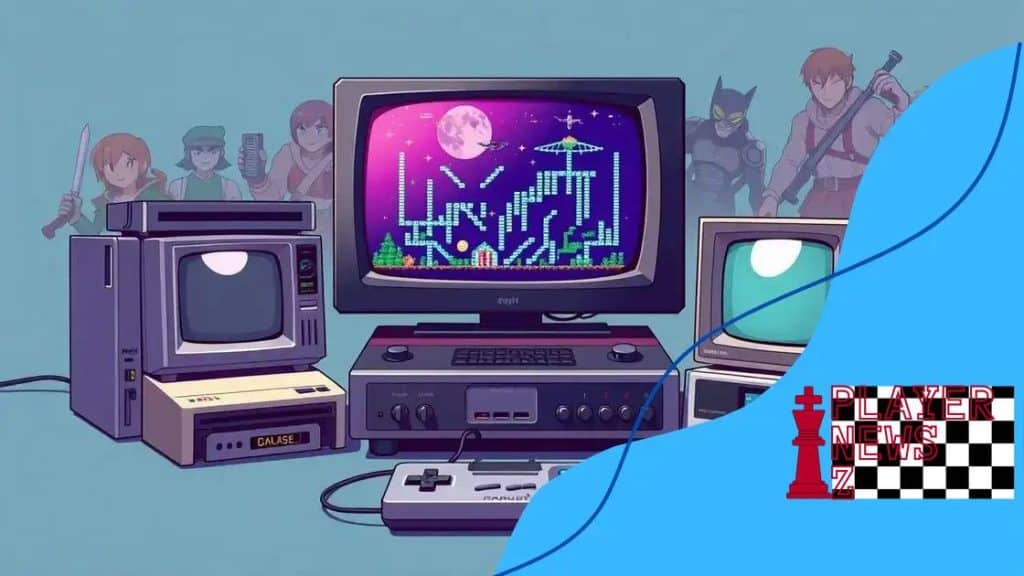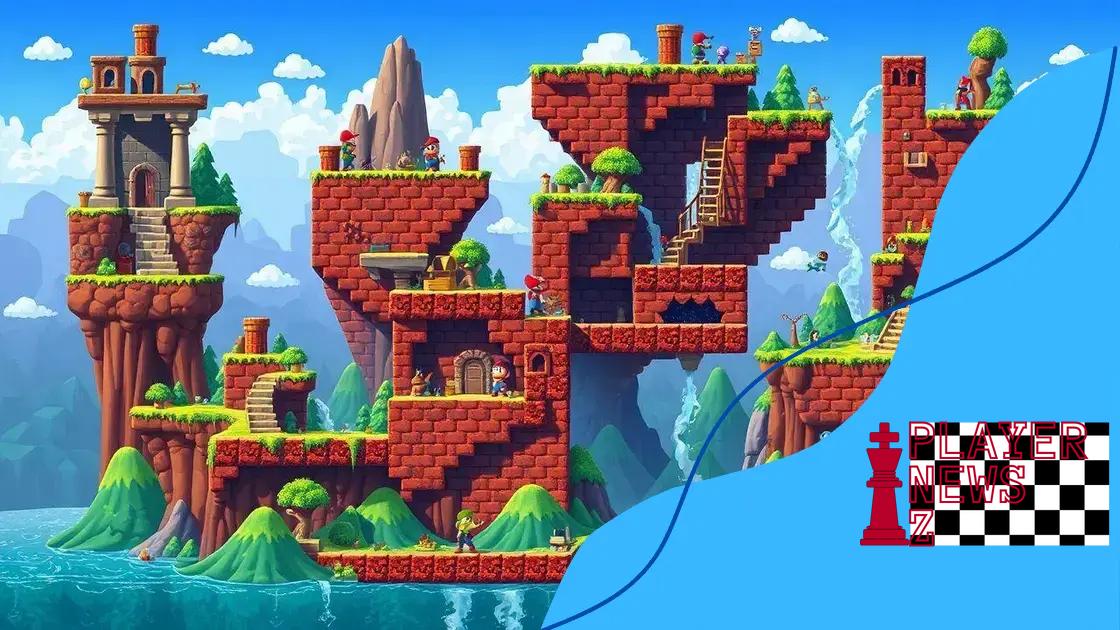How retro games influenced modern game design

Retro games influenced modern game design by introducing essential elements like pixel art, engaging soundtracks, and simple mechanics, which continue to inspire today’s developers and enhance player experience.
How retro games influenced modern game design is a fascinating journey into the past that still shapes our gaming experience today. Have you ever wondered how those early games laid the foundation for what we enjoy now? Let’s explore!
The charm of pixel art and simple mechanics
The charm of pixel art is undeniable. This art style, born from technological limitations, captivated gamers in the early days. Each tiny block of color tells a story and evokes nostalgia. Many modern games still embrace this style, proving that simplicity can lead to engaging gameplay.
Why Pixel Art Matters
Pixel art holds a special place in the hearts of many gamers. It’s not just about visuals; it’s also about the experience.
- Creates a sense of nostalgia for older gamers.
- Offers a unique aesthetic that’s easily recognizable.
- Encourages creativity within limited design constraints.
This simplicity isn’t a limitation; instead, it allows players to focus on the gameplay itself. Many retro titles relied on straightforward mechanics, which taught game developers valuable lessons in clarity and engagement.
The Power of Simple Mechanics
Simple game mechanics are another reason retro games thrive. Games like Super Mario Bros. and Pong taught us that compelling gameplay doesn’t require complex controls.
- Easy to learn but hard to master.
- Encourages player exploration and discovery.
- Facilitates a wide audience appeal.
Modern game designers often draw inspiration from these mechanics, proving the lasting impact of retro games. By keeping gameplay accessible, they reach a broader audience—something crucial for any successful game today.
Overall, both pixel art and simple mechanics are vital elements of gaming history. They shaped how games are made and played today, reminding us that sometimes less is more.
How 8-bit soundtracks set the mood
The 8-bit soundtracks of retro games play a crucial role in setting the mood. These catchy tunes made a lasting impression, enhancing the gaming experience. Players often remember these melodies fondly, as they evoke feelings of nostalgia and excitement.
The Importance of Sound in Gaming
Sound is more than just background noise in video games; it creates atmosphere. A well-composed soundtrack can transport players into another world.
- Guides players through the emotional journey.
- Aligns with visual elements to enhance storytelling.
- Provides cues for gameplay, like enemy encounters.
In retro games, the limitations in technology led to innovative solutions. Composers turned to 8-bit sounds to create memorable scores. This format allowed for creativity within constraints, resulting in iconic tracks.
Memorable Examples of 8-Bit Music
Many classic games introduced unforgettable soundtracks that are still celebrated today. For instance, the music from Legend of Zelda and Super Mario Bros. defined the childhoods of many gamers. These tunes are instantly recognizable and remain popular in modern gaming culture.
- The repeating melodies create a sense of adventure.
- Catchy themes encourage players to replay levels.
- Enhanced player engagement through rhythm and tempo.
Modern games often pay homage to this style. Many developers use 8-bit tracks to create a sense of charm and nostalgia. By incorporating these retro sounds, they bridge the gap between past and present, reminding players of where gaming began.
Level design lessons from classic titles

Level design in classic titles teaches us valuable lessons that still apply today. These games created environments that challenged players while remaining fun and engaging. Good level design is crucial for keeping players interested and motivating them to continue.
Key Principles of Classic Level Design
Many classic games excelled in crafting levels that felt interconnected. They used various techniques to guide players through challenges. Some key principles include:
- Clear objectives: Players always knew what to do next.
- Balanced difficulty: Levels gradually increased challenges.
- Exploration rewards: Hidden items encouraged players to explore.
These principles helped create memorable gaming experiences. Players felt a sense of achievement as they navigated through each level.
Iconic Examples to Consider
Some iconic games provide great examples of excellent level design. For instance, Super Mario Bros. introduced players to varied environments that were colorful and unique. Each world had distinct themes, making every level feel fresh.
- The Legend of Zelda: Players explored dungeons filled with puzzles.
- Metroid: The non-linear map encouraged backtracking and discovery.
- Sonic the Hedgehog: Fast-paced levels and loops kept gameplay exciting.
These titles taught designers the importance of pacing and variety. A well-crafted level encourages players to keep moving, as they encounter surprises and challenges.
By learning from these classic design lessons, modern developers can create engaging experiences that pay tribute to the roots of gaming while pushing boundaries.
Nostalgia and its role in game culture
Nostalgia plays a significant role in shaping game culture today. It connects gamers to their past experiences, making them feel a deep sense of attachment to certain games. This emotional connection drives gamers to revisit classics or seek out similar new titles.
The Impact of Nostalgia on Game Design
Game designers often leverage nostalgia to create engaging experiences. By incorporating familiar elements into new games, developers tap into players’ fond memories.
- Familiar visuals: Retro graphics evoke memories of classic games.
- Classic game mechanics: Simple controls resonate with seasoned players.
- Callbacks to older narratives: Many stories reference beloved franchises.
The blending of old and new creates a unique gaming experience that appeals to a broad audience. Nostalgic elements help reintroduce concepts that made earlier games great.
Nostalgia in Modern Titles
Many modern games draw inspiration from the past, often becoming popular because of their nostalgic appeal. Titles like Shovel Knight and Celeste incorporate retro graphics and gameplay styles while adding fresh twists.
- Retro indie games: Many indie developers focus on nostalgia.
- Remakes and remasters: Updated versions of classic games attract old fans.
- Nostalgic merchandise: Merchandise featuring classic characters remains popular.
Players often find comfort in these familiar elements. This connection encourages engagement, making gamers more likely to share their experiences with others, fostering a strong community around both old and new titles.
Modern interpretations of retro gameplay
Modern interpretations of retro gameplay blend nostalgic elements with contemporary design. Many game developers draw inspiration from classic titles while adding new features that appeal to today’s audience. This approach creates an engaging experience that pays homage to the past.
The Blend of Old and New
By incorporating retro gameplay mechanics, modern games offer a familiar yet fresh experience. This fusion attracts both older gamers and a younger audience. Some key aspects of this blend include:
- Pixel art graphics: Many new games use vibrant pixel art to capture the look of classics.
- Simplified controls: Games often utilize straightforward mechanics for easy accessibility.
- Nostalgic soundtracks: Modern games feature music reminiscent of 8-bit scores.
This balance allows players to feel connected to the gaming legacy while enjoying new storylines and technologies. It creates a unique space where both old and new elements coexist harmoniously.
Successful Examples in the Market
Several recent titles showcase how effectively developers reinterpret retro gameplay. Games like Stardew Valley and Undertale embrace classic mechanics while providing fresh narratives. They resonate with players by reminding them of earlier gaming experiences.
- Stardew Valley: Blends farming simulation with an engaging storyline.
- Shovel Knight: Merges classic platform elements with modern game design.
- Celeste: Offers challenging gameplay with a heartfelt story.
These games maintain the spirit of retro titles while evolving to meet current player expectations. They encourage both exploration and innovation, making them stand out in today’s gaming landscape.
In summary, retro games have greatly influenced modern game design. From pixel art and soundtracks to level design and nostalgia, these elements continue to shape how games are created today. Developers now blend classic gameplay with innovative features, connecting with players of all ages. The revival of retro elements not only celebrates gaming history but also helps to foster a strong community among gamers who cherish these experiences.
FAQ – Questions about how retro games influenced modern game design
How did retro games influence modern game design?
Retro games introduced key elements like pixel art, simple mechanics, and engaging soundtracks that still inspire today’s developers.
What role does nostalgia play in gaming?
Nostalgia helps connect players to their past experiences, making them more likely to enjoy modern games that reference classic titles.
Can modern games successfully incorporate retro elements?
Yes, many modern games blend retro graphics and mechanics with new features to appeal to both nostalgic gamers and new players.
What lessons can we learn from classic level design?
Classic games taught important design principles, such as balanced difficulty, clear objectives, and rewarding exploration, that are vital for engaging gameplay.





